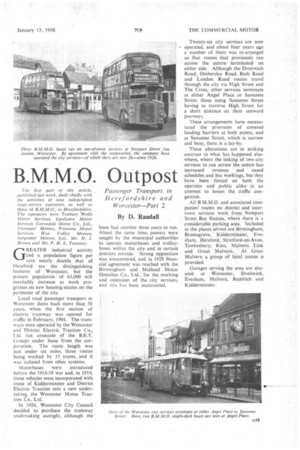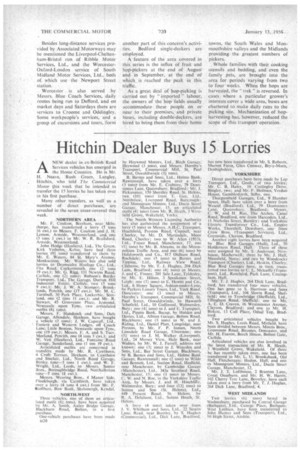B.M.M.O.
Page 65

Page 66

If you've noticed an error in this article please click here to report it so we can fix it.
Outpost
Passenger Transport in Herefordshire and Worcester—Part 2
By D. Randall
The first part of this .article, published last week, dealt chiefly with the activities of nine independent stage-service operators, as well • as those of B.M.M.0„ in Herefordshire. The operators were Tenhury 'Wells Motor Services, Eardiston Motor Services, Corvedale Motor Co,, Ltd., Yeomans' Motors, Primrose Motor Services, Wye Valley Motors, Sargeants' Motors, Ltd., Mr. D. J. Brown and Mr. P. H. E. Turnmey. GREATER industrial activity and a population figure per acre nearly double that of Hereford are the distinguishing features of Worcester, but the present population of 63,000 will inevitably increase as work progresses on new housing estates on the perimeter of the city.
Local road passenger transport in Worcester dates back more than 50 years, when the first section of electric tramway was opened for traffic in February, 1904. The tramways were operated by the Worcester and District Electric Traction Co., Ltd. (an associate of the B.E.T. Group) under lease from the corporation. The route length was just under six miles, three routes being worked by 15 trams, and it was isolated from other systems.
Motorbuses were introduced before the 1914-18 war and, in 1914, these vehicles were incorporated with those of Kidderminster and District Electric Traction into a new undertaking, the Worcester Motor Traction Co., Ltd.
In 1926, Worcester City Council decided to purchase the tramway undertaking outright, although the lease had another three years to run. About the same time, powers were sought by the municipal authorities to operate motorbuses and trolleybuses within the city and in certain districts outside. Strong opposition was encountered, and in 1928 financial agreement was reached with the Birmingham and Midland Motor Omnibus Co., Ltd., for the working and extension of the city services, and this has been maintained.
Twenty-six city services are now operated, and about four years ago a number of them was re-arranged so that routes that previously ran across the centre terminatedon either side. Although the Droitwich Road, Ombersley Road, Bath Road and London Road routes travel through the city via High Street and The Cross, other services terminate at either Angel Place or Sansome Street, those. using Sansome Street having to traverse High Street for a short distance on their outward journeys.
These arrangements have necessitated the provision of covered loading barriers at both points, and at Sansome Street, which is narrow and busy, there is a lay-by.
These alterations are in striking contrast to what has happened elsewhere, where the linking of two city services to run across the centre has increased revenue and eased schedules and bus workings, but they have been forced on both the operatorand public alike in an attempt to lessen the traffic congestion. .
All B.M,M.O. and associated companies' routes on • district and intertown services work from _Newport Street .Bus Station, where there is a considerable parking area. Included in the places served are Birmingham, Broirisgrove,. Kidderminster, Evesham, Hereford,.
Stratford-on-Avon, . Tewkesbury, Ross,. Malvern Link and Great Malvern. At Great Malvern a group of Ideal routes is provided.
Garages serving the area are ated at Worcester, Droitwich, Evesham, Malvern, Redditch and Kidderminster. Besides long-distance services provided by Associated Motorways may be mentioned the Liverpool-Cheltenham-Bristol run of Ribble Motor Services, Ltd., and the WorcesterOxford-London service of South Midland Motor Services, Ltd., both of which use the Newport Street station.
Worcester is also served by Messrs. Blue Coach Services, daily routes being run to Defford, and on market days and Saturdays there are services to Croome and Oddingley. Some workpeoples services, and a group of excursions and tours, form another part of this concern's activities. Bedford single-deckers are employed.
A feature of the area covered in this series is the influx of fruit and hop-pickers at the end of August and in September, at the end of which is reached the peak in this traffic.
As a great deal of hop-picking is carried out by "imported" labour, the owners of the hop fields usually accommodate these people on or near to their premises, and private buses, including double-deckers, are hired to bring them from their home towns, the South Wales and Monmouthshire valleys and the Midlands providing the greatest numbers of pickers.
:Whole families with their cooking utensils and bedding, and even the family pets, are brought into the area for periods varying from two to four weeks. When the hops are harvested, the trek" is reversed. In cases where a particular grower's interests cover a wide area, buses are chartered to make daily runs to the picking site. Mechanization of hopharvesting has, however, reduced the scope of this transport-operation.




























































































































